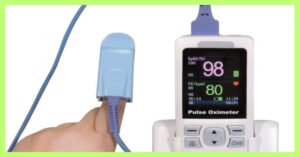
Monitoring your vital signs at home is now easier than ever in the age of smart healthcare. The pulse oximeter is a vital equipment that has grown in popularity. This small and simple device detects your blood oxygen saturation (SpO2) and pulse rate, providing vital information about your general health. However, with so many alternatives on the market, selecting the appropriate pulse oximeter can be difficult. This post will walk you through the process of choosing the finest pulse oximeter for your specific needs and lifestyle.
How to Select the Best Pulse Oximeter
Determine Your Needs
Consider why you require a pulse oximeter before getting one. Are you tracking a chronic health condition or simply trying to stay healthy? Because different models have different characteristics, knowing your objective will help you make an informed decision.
Accuracy Matters
When it comes to health monitoring, precise readings are critical. Look for pulse oximeters that have been clinically verified and have received FDA approval for accuracy. Reading reviews and seeking advice from medical specialists might also point you in the right direction.
Display and Ease of Use
Select a pulse oximeter with an easy-to-read display. This is especially important for older people and people with visual impairments. The device is simple to use thanks to intuitive controls and a user-friendly interface.
Size and Portability
Choose a compact, portable model if you intend to use the pulse oximeter both at home and on the go. These devices are small enough to fit in your pocket or backpack and allow you to monitor your SpO2 levels wherever you go.
Battery Life
Long battery life guarantees that your pulse oximeter is always ready to use. To avoid frequent recharging or battery replacements, go for models with prolonged battery life.
Factors to Consider When Buying a Pulse Oximeter
Type of Pulse Oximeter
Pulse oximeters are classified into two types: fingertip and wrist-worn. Wrist-worn oximeters are more common and convenient for on-the-spot readings, but fingertip oximeters are more common and convenient for on-the-spot measurements.
Display Features
A clear, multi-directional display is beneficial for obtaining accurate readings from various angles. Some models offer adjustable brightness and display rotation, enhancing usability.

Alarm and Alerts
Certain pulse oximeters come with customizable alarms that notify you when your readings fall outside the normal range. This feature can be especially useful for individuals with respiratory conditions.
Top Features to Look for in a Pulse Oximeter
Plethysmograph Waveform
A pulse oximeter with a plethysmograph waveform display provides a visual representation of your pulse strength and rhythm, adding depth to your health insights.
Adjustable Settings
Customizable settings allow you to adapt the device to your preferences, such as adjusting the display orientation or setting personalized alarms.
Data Storage and Connectivity
Advanced models can store and track your readings over time. Some even offer Bluetooth connectivity to sync data with your smartphone or computer for better health management.
Best Pulse Oximeters for Home Use
Choosing the best home pulse oximeter is critical for precise health monitoring. The best alternatives provide accurate readings of oxygen saturation and heart rate. Look for devices with easy-to-use interfaces, customizable display settings, and ergonomic finger placement.They provide dependability and peace of mind for one’s own well-being. Always seek the advice of a medical professional for proper usage and interpretation of results.
Conclusion
Purchasing a pulse oximeter is a sensible investment in proactive health monitoring. You may confidently choose the correct pulse oximeter to accompany you on your health journey by analysing your needs, prioritising accuracy, and evaluating features. Remember that having correct data allows you to make informed decisions regarding your health.
FAQs
How does a pulse oximeter work?
A pulse oximeter measures the oxygen saturation levels in your blood and your heart rate by emitting light through your skin and analyzing the light absorption.
Are fingertip pulse oximeters as accurate as hospital-grade devices?
While fingertip pulse oximeters are generally accurate, they might have slight variations compared to hospital-grade devices due to differences in technology and calibration.
Can I use a pulse oximeter for medical diagnoses?
Pulse oximeters provide valuable insights, but they should not replace professional medical diagnosis. Consult a healthcare provider for proper interpretation of your readings.
Are there any lifestyle factors that can affect pulse oximeter readings?
Yes, factors like nail polish, cold fingers, or poor circulation can impact the accuracy of readings. It’s advisable to follow the manufacturer’s guidelines for optimal usage.
Is continuous monitoring necessary?
Continuous monitoring might be recommended for individuals with certain medical conditions. For general wellness purposes, occasional readings are usually sufficient.






